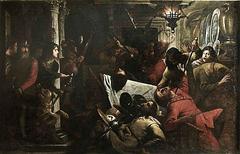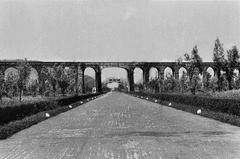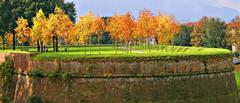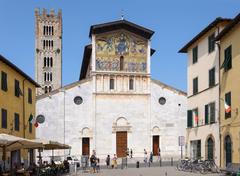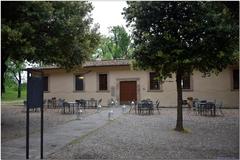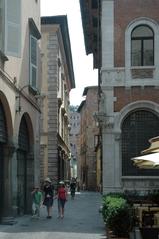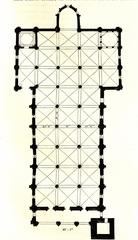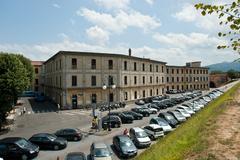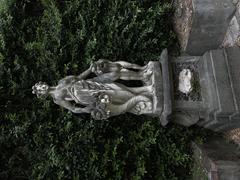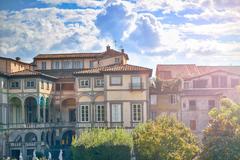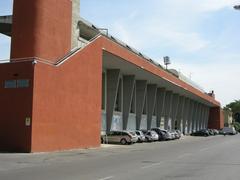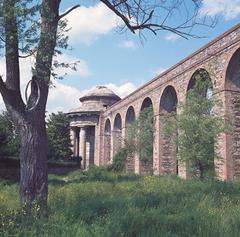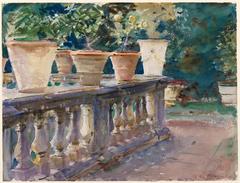
Visiting Municipio in Lucca: A Comprehensive Guide
Date: 20/07/2024
Introduction
Welcome to our comprehensive guide on visiting Municipio in Lucca, Italy! Nestled in the heart of Tuscany, Lucca is a city steeped in history, culture, and architectural marvels. Known for its well-preserved Renaissance walls, Lucca offers a unique blend of ancient charm and modern allure, making it a must-visit destination for history buffs, art lovers, and curious travelers alike. This guide aims to provide you with essential information on visiting hours, ticket prices, and key historical sites to help you plan your visit to this enchanting city.
Lucca’s origins date back to the Etruscan civilization, but it was during the Roman era that the city began to take shape as we know it today. Established as a Roman colony in 180 BC, Lucca’s strategic location along the Via Cassia made it an important hub in ancient times (Visit Tuscany). The city flourished in the Middle Ages, becoming a center of commerce known for its silk industry. By the 11th century, Lucca had established itself as an independent commune, and from the 12th to the 19th century, it was an independent republic, developing a unique cultural and political identity (Italy Magazine).
The Renaissance period brought further prosperity to Lucca, which became a hub for artists, architects, and scholars. The city’s walls, among the best-preserved Renaissance fortifications in Europe, are now a public park offering a unique perspective on Lucca’s history (Lonely Planet). In the 19th century, Lucca was conquered by Napoleon and underwent significant administrative and social reforms. It was later integrated into the Kingdom of Italy in 1860, marking the end of its long history as an independent entity (History Today).
This guide will delve into the historical significance, architectural highlights, and cultural importance of Municipio (Palazzo Orsetti), as well as provide practical information on visiting hours, ticket prices, guided tours, and nearby attractions. Whether you’re planning a short trip or an extended stay, this guide will help you make the most of your visit to Lucca.
Table of Contents
- Introduction
- Historical Background of Municipio, Lucca, Italy
- Architectural and Cultural Landmarks
- Visiting Hours and Ticket Information
- Nearby Attractions and Travel Tips
- Special Events and Guided Tours
- Photographic Spots
- Preservation Efforts
- FAQ
- Conclusion
Historical Background of Municipio, Lucca, Italy
Early History and Roman Influence
Lucca’s origins date back to the Etruscan civilization, but it was during the Roman era that the city began to take shape as we know it today. Founded in 180 BC, Lucca became a Roman colony and was strategically important due to its location along the Via Cassia, a major Roman road. The city’s layout still reflects its Roman heritage, with a grid pattern of streets and the remains of an amphitheater that can be seen in Piazza dell’Anfiteatro (Visit Tuscany).
Medieval Prosperity
During the Middle Ages, Lucca flourished as a center of commerce and trade, particularly known for its silk industry. By the 11th century, Lucca had established itself as an independent commune, governed by its own laws and officials. The city’s wealth during this period is evident in its architecture, including the construction of numerous churches such as San Michele in Foro and the Cathedral of San Martino (Italy Magazine).
The Republic of Lucca
From the 12th to the 19th century, Lucca was an independent republic, one of the few city-states in Italy to maintain its independence for such an extended period. This autonomy allowed Lucca to develop a unique cultural and political identity. The city was known for its republican government, which was characterized by a complex system of checks and balances designed to prevent the concentration of power (Encyclopedia Britannica).
Renaissance and Artistic Heritage
The Renaissance period brought further prosperity to Lucca, which became a hub for artists, architects, and scholars. The city’s walls, which are among the best-preserved Renaissance fortifications in Europe, were constructed during this time. These walls, now a public park, offer a unique perspective on the city’s history and are a testament to its strategic importance and wealth (Lonely Planet).
Napoleonic Era and the Duchy of Lucca
In 1805, Lucca was conquered by Napoleon Bonaparte and became part of the Principality of Lucca and Piombino, ruled by his sister Elisa Bonaparte. This period saw significant administrative and social reforms, including the modernization of the city’s infrastructure. After Napoleon’s fall, the Congress of Vienna in 1815 established the Duchy of Lucca, which was ruled by the Bourbon-Parma family until it was annexed by the Grand Duchy of Tuscany in 1847 (History Today).
Integration into the Kingdom of Italy
Lucca’s integration into the Kingdom of Italy in 1860 marked the end of its long history as an independent entity. The city adapted to its new role within a unified Italy, continuing to thrive as a cultural and economic center. The 19th and 20th centuries saw further development and modernization, but Lucca has managed to retain much of its historical charm and architectural heritage (Italian Tourism Official Website).
Architectural and Cultural Landmarks
Lucca is renowned for its well-preserved historical architecture. Key landmarks include the Guinigi Tower, topped with ancient oak trees, and the Palazzo Pfanner, known for its beautiful gardens and Baroque architecture. The city’s numerous churches, such as the Basilica of San Frediano and the Church of San Giovanni, reflect its rich religious and artistic heritage (Rick Steves Europe).
Visiting Hours and Ticket Information
- Guinigi Tower: Open daily from 9:30 AM to 6:30 PM. Tickets: €4 for adults, €2.50 for children.
- Palazzo Pfanner: Open from March to November, 10:00 AM to 6:00 PM. Tickets: €6.50 for adults, €3.50 for children.
- Cathedral of San Martino: Open daily from 9:00 AM to 7:00 PM. Admission is free, but donations are welcome.
Nearby Attractions and Travel Tips
- Piazza dell’Anfiteatro: A must-visit for its Roman heritage and vibrant atmosphere.
- Piazza Napoleone: Known for its grand architecture and public events.
- Travel Tips: Lucca is best explored on foot or by bike. The city’s flat terrain and compact layout make it easy to navigate.
Special Events and Guided Tours
- Lucca Summer Festival: An annual music festival featuring international artists. Check the official website for dates and ticket prices (Lucca Summer Festival).
- Lucca Comics & Games: One of Europe’s largest comic and gaming conventions, held every autumn.
- Guided Tours: Available through various providers, offering insights into Lucca’s history and culture.
Photographic Spots
- City Walls: Perfect for panoramic views of Lucca.
- Guinigi Tower: Offers a unique vantage point with its rooftop garden.
- Palazzo Pfanner Gardens: Ideal for capturing Baroque architecture and lush greenery.
Preservation Efforts
Efforts to preserve Lucca’s historical heritage are ongoing. The city’s walls, for example, are maintained through a combination of public and private funding, ensuring that they remain a central feature of Lucca’s landscape. Additionally, various restoration projects are regularly undertaken to preserve the city’s numerous historical buildings and monuments (UNESCO World Heritage Centre).
FAQ
- What are the visiting hours for Lucca’s main attractions?
- Visiting hours vary by attraction but generally range from 9:00 AM to 7:00 PM.
- How much do tickets cost for Lucca’s historical sites?
- Ticket prices vary: Guinigi Tower (€4 for adults), Palazzo Pfanner (€6.50 for adults), Cathedral of San Martino (free, donations welcome).
- Are there guided tours available in Lucca?
- Yes, guided tours are available and can be booked through various providers.
Conclusion
Lucca’s rich history, from its Roman origins to its modern-day significance, makes it a fascinating destination for visitors. The city’s well-preserved architecture, cultural landmarks, and vibrant events offer a unique glimpse into its storied past and enduring legacy. Whether exploring its ancient streets or participating in its contemporary cultural scene, visitors to Lucca are sure to find a city that beautifully blends history and modernity. For more updates, download the mobile app Audiala and follow us on social media.
References
- Visit Tuscany. Lucca. Retrieved from Visit Tuscany.
- Italy Magazine. Lucca. Retrieved from Italy Magazine.
- Lonely Planet. Lucca. Retrieved from Lonely Planet.
- History Today. Napoleon and Italy. Retrieved from History Today.
- Rick Steves Europe. Lucca. Retrieved from Rick Steves Europe.
- Lucca Summer Festival. Retrieved from Lucca Summer Festival.
